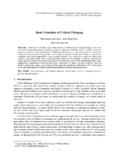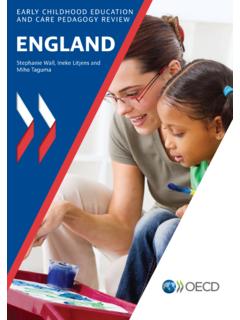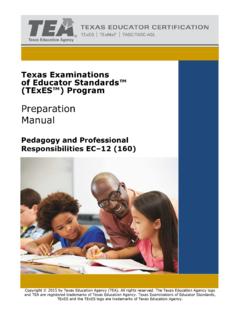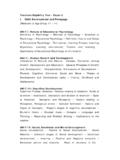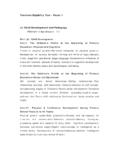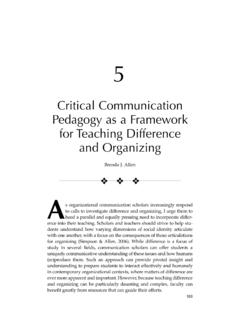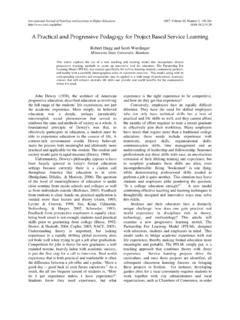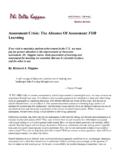Transcription of OUR PEDAGOGY The Seven Principles for Inclusive …
1 Education 2011 TANENBAUM / Center for Interreligious Understanding / 254 W. 31st Street, New York, NY 10001 / (212) 967-7707 / OUR PEDAGOGY The Seven Principles for Inclusive EducationThe Seven Principles for Inclusive EducationThe Seven Principles for Inclusive EducationThe Seven Principles for Inclusive Education 1. Teaching All Students Students learn in different ways. It is, therefore, important to develop the skills to teach in differ-ent ways. For example, some students learn best when introduced to information visually, while others learn best through hearing information, working in groups or activity-based projects. By us-ing several different approaches to the same material within the same lesson or activity, information can become more interesting and tangible to a greater number of students.
2 Some ways to accomplish this are: Think of three different ways to teach a of three different ways to teach a of three different ways to teach a of three different ways to teach a lesson. You could teach a new concept or definition by: (1) having students create a web map on newsprint to represent a concept or a definition (visual), (2) giving a brief lecture about the concept or definition (auditory), or (3) having students act out the concept or definition using various clues (kinesthetic). Of course, there are other strategies as well, such as doing a group brainstorm on chart paper to evoke students prior knowledge about what they already know about the topic, reading a story aloud that illustrates the concept or inviting students to draw an illustration of what they guess the concept might mean.
3 There are many modes to uncover student knowledge and expand new ideas. By incorporating at least three different approaches in your instruction, you will have increased your student s learning outcomes by a factor of three. AskAskAskAsk other teachersother teachersother teachersother teachers how they have taught or would teachow they have taught or would teachow they have taught or would teachow they have taught or would teach a lessonh a lessonh a lessonh a lesson. Try out new approaches, even if you may not have used that approach before. Share withShare withShare withShare with your colleaguesyour colleaguesyour colleaguesyour colleagues a lesson that you created and ask if they see evidence of the three learning styles being addressed or have any other ideas or suggestions.
4 Learn from each other! Listen carefully to student's questions and commentsListen carefully to student's questions and commentsListen carefully to student's questions and commentsListen carefully to student's questions and comments. Learning is a dialogue between students and teachers, with both asking questions and seeking answers from each another. Allow and encourage students to feel comfortable enough to ask for more information, or to seek clarification of information that has already been given. Draw upon the prior knowledge and life experience that students bring to the classroom. Integrate their comments and questions authentically into discussion. Expect student's backgrounds and abilities to be differentExpect student's backgrounds and abilities to be differentExpect student's backgrounds and abilities to be differentExpect student's backgrounds and abilities to be different.
5 Try to be considerate of these differences and help the students reflect on their individuality and to cultivate a sense of belonging in your learning community. 2011 TANENBAUM / Center for Interreligious Understanding / 254 W. 31st Street, New York, NY 10001 / (212) 967-7707 / 2. Exploring Multiple Identities Building confidence and affirming identity for students supports their learning. Students who are excited about themselves and other people, and who are inquisitive about the world around them will more easily learn to be compassionate and understanding of people who are different from them. They are less likely to hold negative feelings about others, if they are comfortable with themselves and also with those who are different.
6 Here are some ways to affirm and encourage student s identities: Create acCreate acCreate acCreate activitiestivitiestivitiestivities that help students talk about, and feel pride in, themselves and their unique experiences. EngageEngageEngageEngage students in projectsstudents in projectsstudents in projectsstudents in projects where they can talk about their experiences as it relates to the academic content, so that their experiences gain status by becoming part of academic knowledge. Encourage all aspectsEncourage all aspectsEncourage all aspectsEncourage all aspects of each student's each student's each student's each student's individuality. Let them know it is okay to be themselves.
7 Create an environmentCreate an environmentCreate an environmentCreate an environment where it is safe to wonder and investigate about self and where it is safe to wonder and investigate about self and where it is safe to wonder and investigate about self and where it is safe to wonder and investigate about self and othersothersothersothers. Help students to see that none of us is a final product! Rather, we are all in a constant state of developing as learners and as members of our communities. Discuss all areas in which a student may find opportunities for successDiscuss all areas in which a student may find opportunities for successDiscuss all areas in which a student may find opportunities for successDiscuss all areas in which a student may find opportunities for success academic, artistic, athletic, physical, emotional and personal.
8 Help students understandHelp students understandHelp students understandHelp students understand the ways in which their identities and their experiences may be linked to their gender and sexual identity, their ethnicity and racial identity, or their religious beliefs and religious identity. Maintain a respectfMaintain a respectfMaintain a respectfMaintain a respectful environmentul environmentul environmentul environment among the studentsamong the studentsamong the studentsamong the students. Help them to use respectful language and behaviors with all their classmates and peers. Work with students so that they learn to disagree respectfully. Students should not shy away from conflicting ideas but learn how to use divergent points of view as an opportunity to deepen their understanding of themselves and others.
9 Cultivate a classroom community where questions are welcomed and expected. 3. Preventing Prejudice All of us are influenced by the legacy of institutionalized inequalities that permeate history as well as the stereotyped ideas and images we encounter every day. The best way for an educator to address preconceived stereotypes and to prevent them from escalating into feelings of prejudice and bias is to create awareness. This can be done by discussing students stereotypes in both large and small groups. This topic may bring up some challenges and sensitivities from the class and the teacher, as well. Here are some ways to discuss the topic of prejudice. It is important to talk about all topics the students bring up.
10 If the educator feels uncomfortable speaking about specific topics, please feel free to contact Tanenbaum Tanenbaum Tanenbaum Tanenbaum about ways to address or improve the situation. 2011 TANENBAUM / Center for Interreligious Understanding / 254 W. 31st Street, New York, NY 10001 / (212) 967-7707 / These are a number of suggestions about how to create student awareness of stereotyped beliefs and inequality: Teach explicitly about histories of unfairness, or institutionalized inequalityTeach explicitly about histories of unfairness, or institutionalized inequalityTeach explicitly about histories of unfairness, or institutionalized inequalityTeach explicitly about histories of unfairness, or institutionalized inequality.










